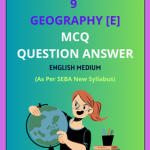SEBA Class 9 Geography MCQ Chapter 5 Concept of Classification of Resources Solutions in English Medium, Class 9 Elective Geography Multiple Choice Question Answer to each chapter is provided in the list so that you can easily browse throughout different chapters SEBA Class 9 Geography MCQ Chapter 5 Concept of Classification of Resources Question Answer and select need one.
SEBA Class 9 Geography MCQ Chapter 5 Concept of Classification of Resources
Also, you can read the SCERT book online in these sections SEBA Class 9 Elective Geography Objective Type Solutions by Expert Teachers as per SCERT (CBSE) Book guidelines. These solutions are part of SCERT All Subject Solutions. Here we have given Assam SEBA Board Class 9 Elective Geography MCQ Solutions for All Subject, You can practice these here.
Concept of Classification of Resources
Chapter – 5
| MCQ |
1. Which of the following Resources can be classified on the basis of origin?
(a) Biotic and Abiotic.
(b) Renewable and Non-renewable.
(c) National and international.
(d) Potential and Developed stocks.
Ans: (a) Biotic and Abiotic.
2. Which of the following Resources can be classified on the basis of Exhaustibility?
(a) Renewable and Non- renewable.
(b) Biotic and Abiotic.
(c) Both.
(d) None of the above.
Ans: (a) Renewable and Non- renewable.
3…………..are obtained from biosphere and have life such as human beings flora and fauna, fisheries, livestock etc.
(a) Abiotic Resources.
(b) Biotic Resources.
(c) Both.
(d) None of the above.
Ans: (b) Biotic Resources.
4. Which of the following resource can be use with the help of existing technical know- how?
(a) Renewable Resources.
(b) Stocks.
(c) Reserves.
(d) None of the above.
Ans: (c) Reserves.
5. The Oceanic Resource beyond 200 km of the Exclusive Economic Zone belong to open ocean and no individual and country can utilize it is
(a) Community resources.
(b) Individual resources.
(c) National resources.
(d) International resources.
Ans: (d) International resources.
6. Resources which are found in a region, but have not been utilised are called…………
(a) Developed resources.
(b) Potential resources.
(c) Stock resources.
(d) International resources.
Ans: (b) Potential resources.
7. Which of the following are examples of community owned resources?
(a) Solar.
(b) Village.
(c) Water resources.
(d) Political resources.
Ans: (c) Water resources.
8. All the resources which are composed of Non- Living things are called…………….
(a) Renewable resources.
(b) Biotic resources.
(c) Abiotic resources.
(d) None of the above.
Ans: (c) Abiotic resources.
9. Which of the following resource can be renewed or reproduced by physical, chemical or mechanical processes?
(a) Wildlife.
(b) Wind energy.
(c) Solar.
(d) All of the above.
Ans: (d) All of the above.
10. All the things which are composed of non living thing are called………….
(a) Abiotic resources.
(b) Biotic resources.
(c) Renewable resources.
(d) Community resources.
Ans: (a) Abiotic resources.
11. Which of the following Resources can be classified on the basis of origin?
(a) Biotic and Abiotic.
(b) Renewable and Non-renewable.
(c) National and international.
(d) Potential and Developed stocks.
Ans: (c) National and international.
12. Which of the following Resources can be classified on the basis of Exhaustibility?
(a) Renewable and Non- renewable.
(b) Biotic and Abiotic.
(c) Both.
(d) None of the above.
Ans: (a) Renewable and Non- renewable.
13-…………..are obtained from biosphere and have life such as human beings flora and fauna, fisheries, livestock etc.
(a) Abiotic Resources.
(b) Biotic Resources.
(c) Both.
(d) None of the above.
Ans: (c) Both.
14- Which of the following resource can be use with the help of existing technical know- how?
(a) Renewable Resources.
(b) Stocks.
(c) Reserves.
(d) None of the above.
Ans: (d) None of the above.
15. The Oceanic Resource beyond 200 km of the Exclusive Economic Zone belong to open ocean and no individual and country can utilise it is called………..
(a) Community resources
(b) Individual resources
(c) National resources
(d) International resources
Ans: (b) Individual resources.

Hi! my Name is Parimal Roy. I have completed my Bachelor’s degree in Philosophy (B.A.) from Silapathar General College. Currently, I am working as an HR Manager at Dev Library. It is a website that provides study materials for students from Class 3 to 12, including SCERT and NCERT notes. It also offers resources for BA, B.Com, B.Sc, and Computer Science, along with postgraduate notes. Besides study materials, the website has novels, eBooks, health and finance articles, biographies, quotes, and more.





